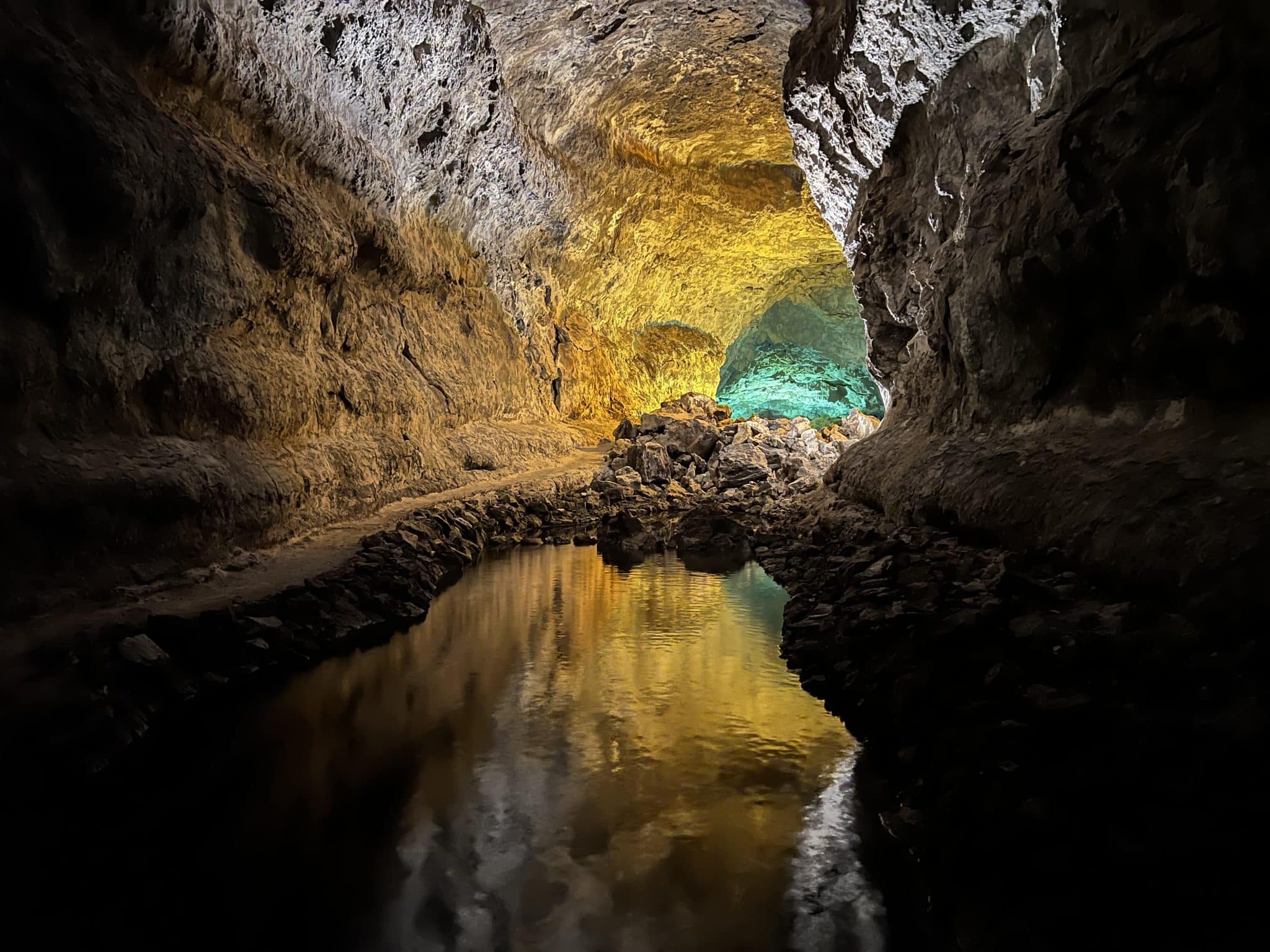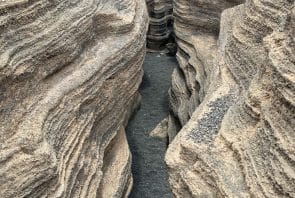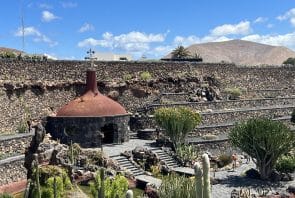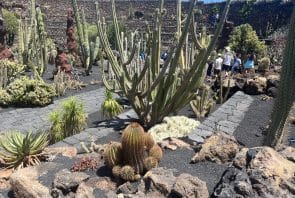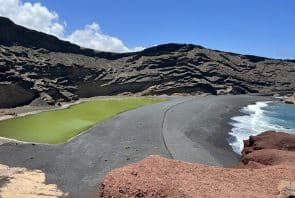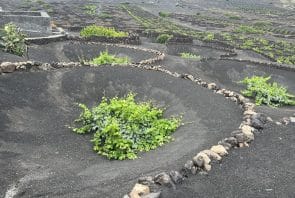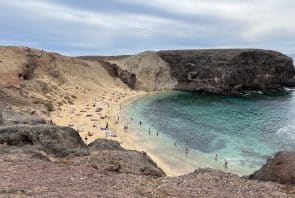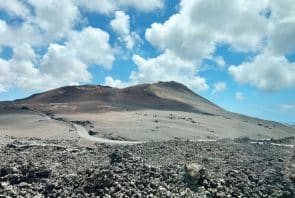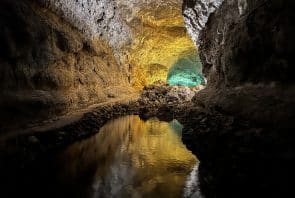What an island! The landscapes are incomparable. Worldwide, there are hardly any parallels to this fascinating stretch of land, formed by repeated and long-lasting volcanic eruptions. Lanzarote is the island of the Canary Islands most affected by volcanism. Even the look out of the window of an airplane creates a science fiction atmosphere. Formations suddenly emerge from bare hills, while fast-moving clouds cast their shadows on a lunar landscape full of unreal shapes and colors – lined with the spray of the roaring ocean.
Lanzarote – Forget the noise of the world
If you pause, you will discover the entire magic of this island. One third of Lanzarote consists of lava, eruption craters and ash mountains. They shimmer pitch black to rusty red in the sun. Snow-white houses offer a harsh contrast. Here, breathtaking natural wonders, the colonial architecture of the Spaniards and impressive works of art enchant you.
In the steppe-stony desert, no forests and hardly any trees thrive. Nevertheless, plant life is stirring: palm trees, colourful flowers and lush cacti adorn the hotel and apartment complexes. Here and there, colorful succulents proliferate, while bright green euphorbias cover the laval fields.
“No tree, no herb”: This is how the German geologist Leopold von Buch described the island, which was marked by volcanic eruptions, around 1825. Even 200 years later, almost a third of the island’s area resembles a lunar landscape rather than a holiday paradise.
Lanzarote has had a particularly hard time of all the Canary Islands. Volcanic eruptions have repeatedly buried the agricultural regions, and the island is almost waterless. In addition, there were periods of drought, pirate raids, economic crises and plagues of locusts. Remarkable: In 1993, UNESCO named the island a “World Biosphere Protected Area”, based on the habitats in which man and nature harmonize to a special degree.
Sea, volcanoes and lots of art
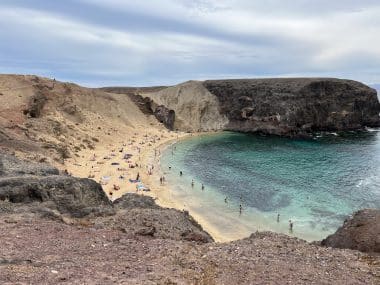
Arrecife, the Timanfaya National Park, Haría, Puerto del Carmen, Costa Teguise or impressive lava grottoes and viewpoints – Lanzarote offers outstanding and above-average sights in a relatively small area.
The island artist César Manrique receives special attention. He succeeded in combining art and nature in a unique way.
The north of Lanzarote
The region is the greenest, rainiest and most scenically varied part of the island. The northwest is dominated by the Risco de Famara mountains.
At the foot of the Famara Mountains lies Haría, the town in the “Valley of a Thousand Palms”. Snow-white houses contact black fields here. It seems African when countless palm trees suddenly appear at the foot of the mountains. This is where César Manrique lived, and where he is buried. His estate can be visited.
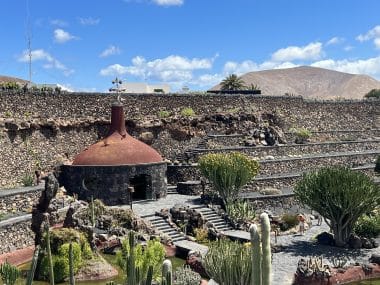
Jardin de Cactus: In the vast basin of a former quarry, a cactus garden was created according to the plans of César Manrique. The Jardin de Cactus was opened in 1990 near Guatiza. Visitors can walk on several floors in the midst of 1420 different cacti and other desert plants. Tall stone columns and deep black lava stones enhance the effect of this ambience – it looks like an alien world.
The cactus garden was his last work – César Manrique died in a traffic accident in 1992.
A visit to the magnificent Mirador del Rio viewpoint is a must. The Mirador is a viewpoint with a café-restaurant carved directly into the rock on the site of an old observation post in the far north of Lanzarote at an altitude of 479 metres – an impressive work by César Manrique.
A trip to the offshore eighth Canary Island of La Graciosa is also worthwhile. The graceful beauty can be reached by boat. Every day, the small barges swing like nutshells on the water. From Orzola, boats cross to Caleto del Sebo several times a day. You should choose a quiet day for the crossing. Even in reasonably calm seas, the waves are remarkable.
Where vines duck into small craters – the centre of Lanzarote
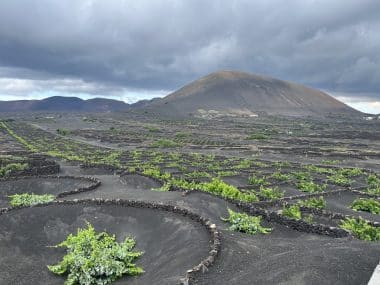
This is where Arrecife is located, overlooked by two castles. The main town of the island is not particularly beautiful, but authentic and lively. Particularly worth seeing is the drawbridge, which creates the connection to an upstream mini-island. Here is the Castillo de San Gabriel from the 16th century. From its roof, there is a wonderful view over the city.
Just a few kilometers to the south, lies the gigantic resort town of Puerto del Carmen with four enchanting sandy beaches. At Playa Granda, the best beach of all, loungers and colorful parasols are neatly lined up in Prussian order. A conglomerate of shopping centres, residential complexes, discos and restaurants stretches along the coast over a length of ten kilometres. The town offers all the amenities expected of a holiday resort. Night owls will find iconic music bars on Avenda de las Playas in the Centro Arena Dorada.
North of the capital, the colonial old town of Teguise inspires. On the Costa Teguise, windsurfers will find their Dorado.
La Geria is the most famous wine-growing region in Lanzarote. The Weintal looks like a stroke of genius by gifted landscape architects. The attractive valley stretches across Masdache to Uga in the south.
By the way, Uga is the last inhabited place on the Fire Mountains. In the core area of the eruptions of the hamlets of Timanfaya , Uga is the only village to have been rebuilt. The lovingly prepared front gardens look like colorful splashes of color in a bizarre landscape.
To the Fire Mountains – welcome to Timanfaya National Park!
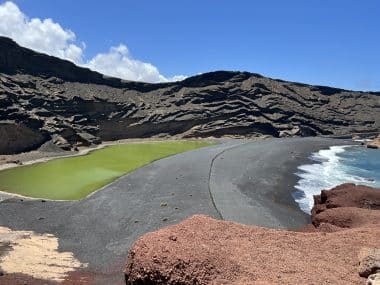
Here, the volcanic heritage is skilfully staged. Through a landscape of gloomy violence, you reach the bizarre Fire Mountains, which present themselves eerie and primeval in nature. They were only formed from years of violent magma eruptions in the middle of the 18th century. Born of the earth’s heat, torn crater flanks shimmer bizarrely in all earth colors. On the way in the national park, you get an intensive insight into the “creation story” of the Canary Islands.
At the southern end of the island – fascination of the desert
It’s hard to resist the desert charm of Lanzarote’s driest region. A few inconspicuous grasses, some colorful lichens – a land parched by the sun. This is what it may look like on the edge of the Sahara. That means: sun guarantee!
The fishing village of Playa Blanca could develop into a huge holiday area here. The new Maris Rubicón district is particularly successful architecturally. The Playas de Papagayo offers the most beautiful beaches on the island. In the east of the holiday town, they are the attraction.
Another highlight is a deep green lagoon. The Charco de los Clicos lies in the shape of a crescent in the arch of a sunken crater basin. In contrast to the dark blue Atlantic Ocean with white spray and pitch-black lava sand, it is an unforgettable sight.
Spain’s star director Pedro Almodóvar once enthused: “I have never seen such dramatic colors in nature.”
The Fire Mountains as well as the deep green lagoon provided a great backdrop for many a science fiction film. The fantasy remake “Clash of the Titans” (2010) was also made here.
Questions and answers about Lanzarote
What is the weather like in Lanzarote?
Weather in Lanzarote
| Month | Average temperature (°C) | Precipitation (mm) | Sunny days |
|---|---|---|---|
| January | 17 | 14 | 6 |
| February | 17 | 12 | 7 |
| March | 18 | 9 | 8 |
| April | 19 | 5 | 9 |
| May | 21 | 2 | 10 |
| June | 24 | 0 | 11 |
| July | 27 | 0 | 11 |
| August | 28 | 0 | 10 |
| September | 26 | 3 | 9 |
| October | 24 | 12 | 8 |
| November | 21 | 20 | 7 |
| December | 18 | 17 | 6 |
What is the name of the most famous citizen of Lanzarote?
The most famous citizen of Lanzarote is undoubtedly César Manrique. César Manrique was a Spanish artist, architect and environmentalist who was born in Lanzarote and played a significant role in preserving and shaping the island’s natural and cultural environment. He is particularly known for his unique architectural works and his commitment to environmental protection in Lanzarote. Manrique’s influence and legacy are pervasive on the island and have helped make Lanzarote a popular destination for tourists from all over the world.
What special holidays are celebrated?
- Day of the Canary Islands (Día de Canarias): On May 30th, the Day of the Canary Islands is celebrated, in which the inhabitants of Lanzarote celebrate the cultural identity and history of the Canary Islands.
- Carnival (Carnaval): Carnival is celebrated extensively in Lanzarote, as in most of the Canary Islands. The exact dates vary from year to year, as they depend on the date of Easter. The festivities include parades, costume contests, and street parties.
- Día de San Juan (St. John’s Day): On June 24, the Día de San Juan is celebrated, when fireworks and bonfires are lit. This day marks the beginning of summer and is often celebrated with beach parties and other activities.
- Day of the Virgin Carmen (Virgen del Carmen): This religious holiday is celebrated on July 16 and honors the patron saint of fishermen. Processions and events take place in coastal communities, especially in Puerto del Carmen.
- Canary Islands Autonomy Day (Día de la Autonomía de Canarias): On August 10, the autonomy of the Canary Islands is celebrated. This is a holiday where local events and activities take place.
- Christmas (Navidad): Like everywhere else in the world, the Christmas holidays are celebrated in Lanzarote. These include festive decorations, Christmas markets, and religious events.
How long is the flight from Germany to Lanzarote?
The flight time from Germany airports to Lanzarote depends on several factors, including the departure airport in Germany, the flight route, and whether there are direct flights. As a rule, a direct flight from Germany to Lanzarote takes about 4 to 4.5 hours.
Here are some estimated flight times from different UK airports to Lanzarote (Arrecife Airport):
- Frankfurt am Main to Arrecife: About 4 to 4.5 hours
- Munich to Arrecife: About 4 to 4.5 hours
- Berlin to Arrecife: About 4 to 4.5 hours
- Dusseldorf to Arrecife: About 4 to 4.5 hours
- Hamburg to Arrecife: About 4 to 4.5 hours
Please note that these are approximate flight times and may vary depending on the flight route, aircraft type and weather conditions. It is always advisable to check the exact flight times and connections with your airline or travel agency before planning a trip to Lanzarote.
You should definitely know these words:
- Hola – Hello
- Buenos días – Good morning
- Buenas tardes – Good day/Good afternoon
- Buenas noches – Good evening/Good night
- Por favor – Please
- Gracias – Thank you
- De nada – Please (in response to “Thank you”)
- Sí – Yes
- No
- ¿Cómo estás? -How are you doing?
- ¿Cuánto cuesta? – How much does it cost?
- ¿Dónde está…? – Where is…?
- ¿Cómo llego a…? – How do I get to…?
- Baño – Bathroom
- Comida – Food
- Agua – Water
- Playa – Beach
- Restaurante – Restaurant
- Cerveza – Beer
- Vino – Wine
Important telephone numbers in Lanzarote:
- Emergency ( general emergency): 112 This number is valid throughout Europe for emergencies and is the first number you should call in any serious emergency.
- Police (Guardia Civil): 062 For law enforcement and security issues, you should contact the local police.
- Fire Brigade (Bomberos): 080 For fire and rescue services, you should call the local fire department.
- Medical Emergency/Ambulance: 061 If you need medical assistance or an ambulance, call this number.
- Poison Control Centre: 91 562 04 20 In case of poisoning or toxic contamination, you can contact the National Poison Centre.
- Tourist information: The local tourist offices in Lanzarote offer assistance to tourists. The exact phone numbers may vary depending on your location, but you can usually search for “Oficina de Turismo Lanzarote” on the internet to find the contact information for the tourist office in your area.
Paying in Lanzarote
- Currency: The official currency in Lanzarote and throughout Spain is the Euro (EUR). It is advisable to have a few euros in cash with you, especially for small purchases and for places that may not accept credit cards.
- ATMs: ATMs are common in Lanzarote and can be found in towns, tourist areas and bank branches. Most ATMs accept international credit and debit cards. However, be aware of any fees that may apply to cash withdrawals, especially if you use a foreign card.
- Credit cards: Credit cards are accepted in most hotels, restaurants, shops and car rental agencies in Lanzarote. Visa and Mastercard are widely available, while American Express and Discover may be less accepted. Nevertheless, it is advisable to always have some cash with you.
- Tipping: In restaurants and cafés, tipping is usually not included in the bill amount. It is customary to leave about 10% to 15% of the bill amount as a tip if the service is not already included on the bill. In bars, you can give small change as a tip.
- Price negotiation: Price negotiation is not common in Lanzarote, except perhaps in local markets and with independent sellers. In shops and restaurants, prices are usually fixed.
- Bank opening hours: Most banks in Lanzarote are open from Monday to Friday from 8:30 am to 2:00 pm. Some banks also offer branches open in the afternoon. However, ATMs are available around the clock.
- Traveller’s cheques: Traveller’s cheques are not as widely accepted in Lanzarote as credit and debit cards. It may be difficult to cash them, and you may have to pay fees for exchanging traveler’s checks.
What are the main attractions in Lanzarote?
-
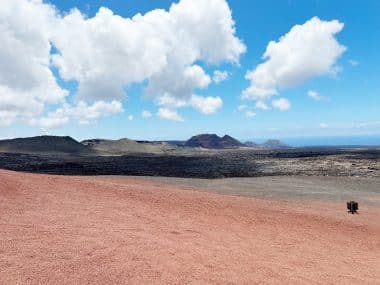
Timanfaya National Park, Image: Travel Magazine Online
Timanfaya National Park
: This volcanic landscape is breathtaking, featuring geysers, hot springs, and extinct volcanoes. It is one of the main characteristics of Lanzarote.
Cueva de los Verdes
: These underground caves are part of Lanzarote’s lava tunnel system and offer fascinating geological formations.
Jameos del Agua
: Another impressive cave system designed by César Manrique that features an underground lake, concert hall, and restaurant.
Mirador del Río
: A viewpoint on a cliff that offers stunning views of the neighboring island of La Graciosa and the surrounding waters.
El Golfo
: A green crater lake next to a black sand beach with a half-submerged volcanic cone.- Castillo de San José: An 18th-century historic castle that now houses an arts and culture center.
- La Geria: A unique wine-growing area where vines are planted in crescent-shaped hollows to protect against wind and weather conditions.
- Fundación César Manrique: The former home and studio of the famous artist and environmentalist César Manrique, which is now a museum.
- Teguise: A charming, historic town with cobblestone streets and a weekly flea market.
- Papagayo Beaches: A group of beautiful beaches in the south of the island with crystal clear waters and golden sand.
- Los Hervideros: A fascinating coastal landscape with natural lava formations and waves splashing against the rocks.
- Haria: Also known as the “Valley of a Thousand Palm Trees”, Haria is a picturesque village with lush vegetation and charming ambiance.
Our tip: At the ticket offices, you can purchase combo packages for various attractions. This will save you money if you want to see different sights in Lanzarote.


